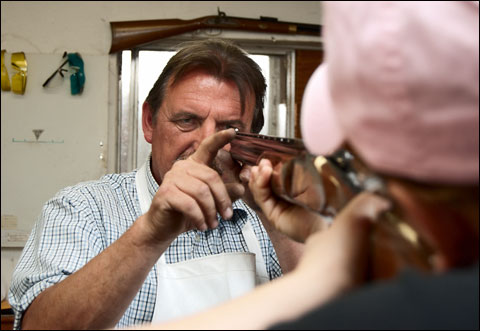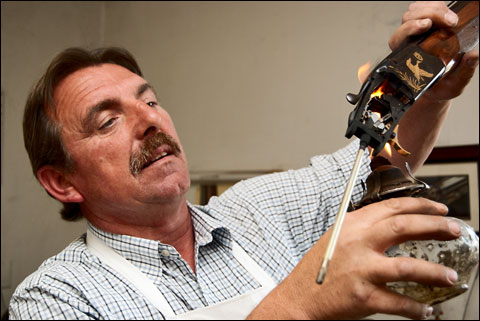Five Things You Need to Know When Teaching a Woman How to Shoot a Shotgun
Learning to shoot and hunt at the age of 41 was such a revelation to me that I find myself constantly offering to help other women get into the shooting sports. Often, all it takes is the mere mention that I hunt to pique other women’s interest. Over and over, I’ve watched their eyes light up as the mental calculation leads them to the obvious: “If she can do it, I can do it too.”
It’s a good thing that part is so easy, because everything after that takes a bit more care and planning. Here are some things you need to consider when introducing women to shotguns:
1. The recoil monster. Many women I’ve met fear recoil more than anything else. What feels to me like a little shove looks to them like the recoil of a giant World War II anti-aircraft gun. Sometimes I’ll try to demonstrate what the recoil of my gun feels like by giving them a shove to the shoulder. Unfortunately, most women don’t like being shoved, so I can’t recommend that.
Here’s what I can recommend, though: a .410. While it’s safe to say most of us wouldn’t recommend .410s for hunting all upland birds and waterfowl, there’s no harm in starting women with a gun that pops like a .22 before moving them toward the big guns. It’s the equivalent of jumping off the side of the pool before ascending the high dive.
2. Eye dominance. Most common shotguns are cast for right-handed shooters because most people are right-handed. But while 80 percent of men have dominant eyes that match their dominant hands, 80 percent of women don’t. That means a lot of us will be left-eye dominant.
So if you’re teaching a woman to shoot a shotgun, determine which eye is her dominant eye before ever letting her lay a hand on a shotgun. If she’s left-eyed, have her shoot left-handed. Really, it’s OK: If a woman has never held a gun right-handed, it’s not going to feel awkward holding it left-handed. It’s just going to feel awkward, period. (Trust me – I’m one of these women.)
In some cases, though, matching our trigger hand to our dominant eye may not be enough because we’re either center-dominant (neither eye wins) or our dominance shifts back and forth. That would be me. I discovered this early on when I was hunting ducks on a dull and flightless day and decided to check my aim on some of our decoys. My sight picture bobbled, and when I closed my right eye, I found that I was pointing the gun way off to the side of that decoy. Yikes!
After that I went through a horrible adjustment period. I tried putting Vaseline on the center the lens on the right side of my shooting glasses. I tried tape. But while this was fine in a skeet field, it was not fine for hunting ducks, because I was obscuring way too much of the sky, making it hard to search for incoming birds.
Finally I settled on closing my right eye just before shooting, after I’ve already used my binocular vision to determine that the birds are in range. I know it’s not ideal, but it works for me.
3. Gun fit. Most shooters understand that women are smaller than men, and they recommend that the smallest among us consider youth guns, or at least have a gunsmith saw off a bit of our stocks to shorten the length of pull.
That’s not enough for most of us, and the last section should make clear why. Given the overwhelming number of cross-dominant women who really should be shooting left-handed, it’s absolutely vital that we buy guns that can be cast for left-handed shooting.
For autoloaders and pumps, we need to make sure the guns come with shim kits that alter cast and drop, or at least that we can special-order them. And for double guns, we need to factor in the cost of a trip to a reputable gunsmith to make those adjustments. Gunmaker Dale Tate at the Camanche Hills Hunting Preserve in Ione, Calif., is my guy. He fitted my first autoloader, and has done fittings and lessons for scores of my friends as well – he’s terrific.
 Dale Tate checks the fit of a shotgun.
Dale Tate checks the fit of a shotgun.
 Dale Tate uses lampblack to find spots where the now-altered wood stock doesn’t meet the action perfectly.
Dale Tate uses lampblack to find spots where the now-altered wood stock doesn’t meet the action perfectly.
4. Weight and weights. Here’s where we loop back to that first problem: the recoil monster. Most women want to carry lighter shotguns, and many buy 20 gauges for that reason. But it’s important for us to explain to them that all other things being equal, a lighter gun means the shooter feels more recoil. A 12 gauge may have less felt recoil than a 20, depending on the type of ammunition used, the quality of the gun’s recoil pad and whether it has any recoil absorption systems.
The simplest solution to this problem is to advise the shooter to buy the gun that best fits her needs, and if it’s a little heavy, do some weight lifting to strengthen her arms and upper body.
5. Wiring. Men, I’m probably not the first one who’s told you that we women are wired differently than you are, but here’s what you need to know about how our wiring pertains to our shooting:
First, we are collaborative, not competitive. Watch a group of women shooting together and you’ll often see that we cheer each other on loudly, and a LOT. Watch a group of men shooting together and you’ll often see that they like to rib each other at times. Don’t rib us! It’s hard enough just trying what’s widely considered to be a man’s sport without being put down, even if it’s in jest.
Second – and you’ll like this part – we take directions well. Every shooting instructor I’ve ever met says women follow instructions far better than men do. We actually want you to tell us what to do, preferably calmly.
Last year, I hunted ducks with a woman who’d done no traditional duck hunting – she’d gone jump shooting once, but had never hunted from a blind located in a waterfowl hot spot. I told our guide this and he handled it perfectly: When birds were coming in, he whispered calm instructions to her. “See those ducks? Not close enough yet. Watch, watch, watch. OK, get ready. OK, now.”
In giving her directions, he took nothing for granted, but nor did he sound condescending, hurried or distressed if she missed. We had a lot of fun that day. I’ve been recommending him to all the new duck hunters I’ve gotten to know lately ever since.
A. Heyser is a hunter, forager, writer, food photographer and college journalism lecturer. She writes a blog about hunting at http://norcalcazadora.blogspot.com.and shoots food photos for boyfriend Hank Shaw, who writes a blog about wild food at http://honest-food.net.

Holly A. Heyser is a hunter, forager, writer, food photographer and college journalism lecturer. She writes a blog about hunting at http://norcalcazadora.blogspot.com.and shoots food photos for boyfriend Hank Shaw, who writes a blog about wild food at http://honest-food.net.


Comments